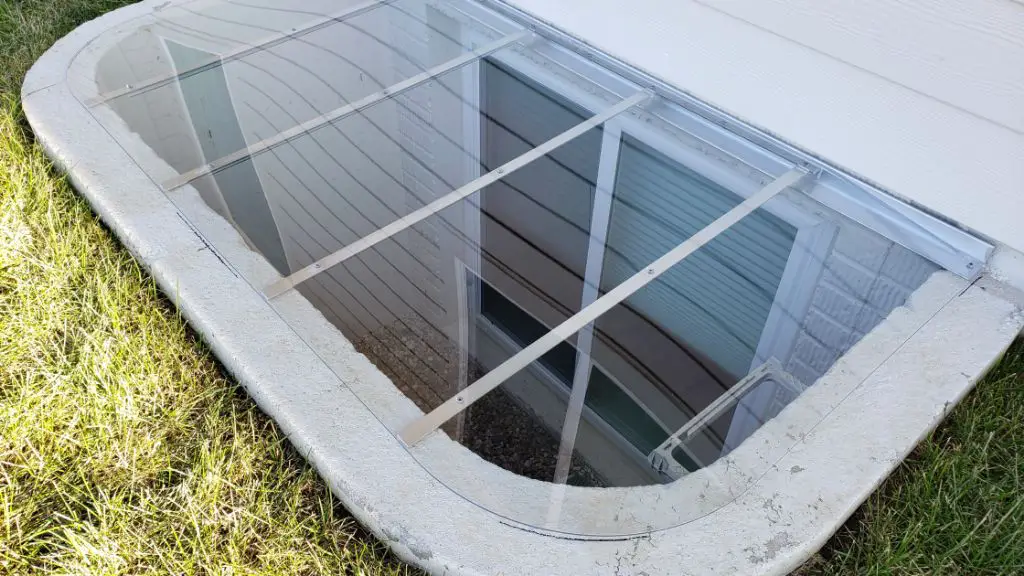Window wells allow natural light and emergency egress to basement windows that are below grade. While it may seem like a good idea to cover them for extra security or to keep out leaves and debris, covering window wells is not recommended for several reasons. In this article, we will explore whether it is okay to cover window wells, the pros and cons, alternatives to covering, and best practices for keeping your window wells functional.
Page Contents
Is Covering Window Wells Allowed?
Most building codes prohibit covering window wells completely. Window wells provide two important safety functions:
- Allow natural light into basement rooms, which improves livability.
- Provide an emergency exit from basement bedrooms or living spaces in case of fire or other emergencies.
Covering a window well completely blocks both the light and emergency egress, creating safety hazards. Most building codes require a minimum open area for light and egress, typically at least 6 square feet with a minimum dimension of 36 inches. Covering the well fully does not meet these code requirements.
Before covering a window well, it’s important to check with your local building department to understand code requirements in your area. Covering wells may require a permit and inspection to ensure proper materials and open area are maintained.
Pros and Cons of Covering Window Wells
While covering window wells completely is not allowed, some homeowners still wish to cover them partially to prevent debris accumulation and for other reasons. Here are some of the pros and cons of covering window wells:
Potential Pros
- Prevent leaves, debris, and dirt from entering window well
- Keep out small animals like rodents or snakes
- Provide extra security by limiting access to basement windows
- Improve aesthetics by hiding the window well
Potential Cons
- Reduce natural light into basement rooms
- Create safety hazards by blocking emergency egress
- Cause moisture problems in window well leading to mold, mildew, and damage
- Require removal for basement access or maintenance
- May violate building codes without proper permits
As you can see, while covering window wells offers some benefits, it also comes with significant risks, which is why building codes prohibit complete coverage.
Alternatives to Covering Window Wells
Instead of covering window wells, experts recommend these alternative approaches to enhance safety and prevent issues:
Install a Window Well Cover
Rather than covering the entire window well, install a removable window well cover. These covers are made of lightweight plastic or fiberglass and attach securely over the window opening itself.
When properly installed, window well covers allow full access to open window well space and the basement window when needed. But when closed, they prevent debris accumulation and animal access while still permitting some light.
Improve Drainage
Adding drainage pipes or gravel at the base of the window well can improve drainage, preventing buildup of moisture. This drainage helps reduce risk of mold and damage to the foundation.
Secure Basement Windows
Replace standard basement windows with secure, egress-type models that include tamper-resistant locks. This improves security while still allowing emergency exits when needed.
Regular Maintenance
With uncovered window wells, be sure to perform regular maintenance:
- Remove any accumulated leaves, mulch or other debris
- Check for any damage and make repairs as needed
- Ensure any drains or pipes are clear of obstructions
- Inspect for signs of moisture or mold and address any issues
Proper maintenance keeps window wells functioning safely.
Best Practices for Window Well Safety and Function
Here are some top tips for making sure your window wells are safe, functional, and free of problems:
- Always keep window wells completely clear and free of blockages for proper egress.
- Consider installing grates or grilles over window wells to prevent falls while still allowing light and exit access.
- Choose window well construction that is non-corrosive and rated for underground use, such as molded polyethylene.
- Slope window well floors slightly toward drainage pipes or gravel beds to encourage water flow away from the foundation.
- Ensure window wells have proper drainage and are free of moisture buildup or mold growth.
- Inspect window wells regularly for any cracks, damage, or signs of deterioration and repair promptly.
- Keep all basement windows operational so they can be used for emergency exits if needed.
- Consider escape ladders for deep window wells to aid in egress.
- Follow all building codes and get proper permits for any modifications or covers.
Adhering to these best practices reduces risks and ensures window wells can function properly and safely.
Conclusion
While covering window wells may seem beneficial, doing so comes with significant safety hazards and code violations. Blocking wells completely prevents natural light, emergency egress, and drainage, creating serious risks. Instead of covers, consider secure window well grates, regular maintenance, proper drainage, and egress-type windows. This preserves the benefits of window wells while enhancing security and function. Always check building codes before modifying window wells and understand the pros and cons involved with any covers or changes. With proper design and maintenance, window wells can provide beautiful natural light, livability, and critical emergency exit access for years to come.
